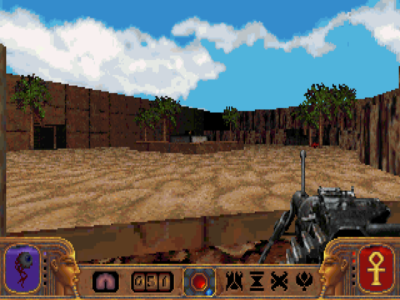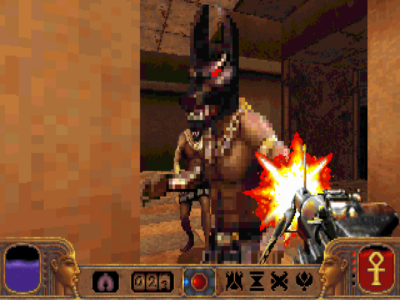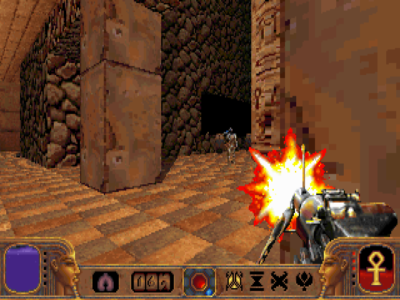
Powerslave
Written by: Stoo
Date posted: April 29, 2007
- Genre: Action
- Developed by: Lobotomy
- Published by: Playmates Interactive Entertainment
- Year released: 1996
- Our score: 5
Tell me why I had to be a powerslave
I don’t wanna die, I’m a god, why can’t I live on?
When the lifegiver dies and all around is laid waste
a slave to the power, slave to the power I am!
This first-person-shooter happens to share both its name, and a general ancient-Egyptian theme, with one of Iron Maiden’s great works from the 1980s. The song Powerslave is essentially the angry monologue of Pharaoh, a man of great power who masquerades as a god before his people. Ultimately though he’s a mortal man, doomed to die just like anyone else, and he rages helplessly against that fact. The album cover art meanwhile featured Maiden’s mascot Eddie, in giant statute form, glaring down from before a pyramid.
There’s no official link here between the game and the works of Maiden, alas. I assume the choice of title is just a shout-out to one of the classics, from a metal fan at Lobotomy. So if you’re after an Iron Maiden shoot-em-up – perhaps blasting through levels based on songs from Seventh Son – sadly the world is still awaiting such a thing. Well there was Ed Hunter, but… it was terrible.
Oh, incidentally this one is known as Exhumed here in Europe. Quite possibly we have lawyers to blame for that one, but I’ll stick with the title that reminds me of awesome riffs.
Anyway, ancient Egypt has proven a good source of material for fantasy over the years. There’s a lot there to stir the imagination – colossal stone structures, painted temples and cold dark tombs beneath the shifting sands. It’s mysterious, awe-inspiring stuff. Then you also have a rich mythology, with a fixation on the afterlife and a host of strange-looking animal-headed gods. It doesn’t seem too much of a leap to add a little sorcery into the mix, to have those ancient corpses get up and start walking again, or something old, terrible and powerful stirring into life from its hidden sepulchre. Or you could even take a sci-fi route, playing on the theme of these mythological powers as beings from another world – as seen in the Stargate series.
In this particular game there’s a bit of both going on. The setting is actually the present day – something weird is going on at the ancient ruins of Luxor and Abu Simbel, and you take on the role of a special-forces guy sent to sort it out. In fact the details of plot aren’t all that interesting – something about aliens drawing power from the spirit of the Pharaoh Rameses, and special-forces guys being sent in to sort the problem out. It’s really just an excuse to run around machine-gunning undead mummies in the head. These were the days when a “plot” in a shooter was usually something jotted down on the back of an envelope, after all.
In terms of technology, Powerslave is powered by the Build Engine, most famously known for its first use in Duke Nukem 3D. While we refer to the genre as being a type of 3D gaming, in fact the games of this generation existed in a kind-of-not-quite-pseudo-3D. Essentially all the maps are drawn as 2D plans, with some parts lowered and others raised. So the third dimension does exist, but you can’t have one room above another (or at least not without some clever tricks, as I understand it). Also your view looks rather distorted when looking up and down, and enemies are represented with various flat sprites rather than polygon models.
These limitations result in level geometry that looks rather simple and boxy by modern standards. Lots of empty rooms and chambers that don’t really seem to serve any purpose. Still, I guess you might picture ruined tombs and temples as square empty chambers anyway. There’s not a huge amount of variety in the scenery, but it does at least go between dashing through sun-baked sandy courtyards, and creeping into underground depths. I wouldn’t say it’s awesomely atmospheric – you never really forget that you’re wondering around a gaming map and not actually descending fearfully into lairs of ancient, awakened evil. Still, the scene is set quite well.
For enemies you would expect two things – evil walking mummies and jackal-headed guys – and both are duly provided. Later on fiendish, teleporting cat-women show up: they blink in, claw at you and disappear again, which is a situation pretty much guaranteed to have you running backwards hammering the fire button at any sign of movement. Surprisingly dangerous meanwhile are the spiders – they’re small and fragile, but also damn fast, and often you don’t notice them until you hear a chewing noise and see the health bar going down.
As for weapons you start with a knife, then a poxy pistol, as again was the norm. Upgrades include a machine-gun (of course) that’s quite satisfying to use and a flamethrower. A couple are magical in nature, like the Exploding Snake Launcher. Which probably has a better name like “Osiris’ Mighty Shaft” or something, I forget, but basically it launchers homing snakes, that are liable to home in on you if they can’t find any other target. The most fun though is when you take hits from a certain kind of mummy attack, causing you to become an one of them yourself. You see your character’s hand go all “evil”, and then he can slam his staff into the ground for a powerful attack. There’s also a Heretic style item inventory – with items like torches, magical health replenishment and weapon damage upgrades.
That’s about it really. There’s not a lot going on here that Doom hadn’t already done. Machinegun blasphemous horrors, collect keys to open successive portions of a level, reach exit. As compared to its peers there’s nothing outstandingly bad or good, hence a fairly brief review. There are certainly shooters of the period I would more highly recommend – Hexen or of course System Shock. This one was a game with no real ambition; it just took a solid and tested template, sticking in the Egyptian theme for flavour. Still it makes a competent enough job of that. If you do have a fondness for the older, simpler days of first-person gaming then you’ll probably find some entertainment.
Slave to the power I am!
Slave to the power I aaaaaam!





 Posts
Posts
This one is going to get a rerelease courtesy of our good friends at Night Dive. They got Kaiser, their technical wizard (examples of his wizardry include Strife: Veteran Edition and the recent rerelease of Turok) on it and apparently they are going to carry over a lot of stuff from the console version which was apparently superior.
February 7, 2016 @ 1:11 am